Search for Helium-like Strangelets in the Atmosphere
P. Mueller,1 L.-B. Wang,1,2 R. J. Holt,1 Z.-T. Lu,1 T. P. O'Connor,1 J. P. Schiffer11Physics Division, Argonne National Laboratory; 2University of Illinois at Urbana-Champaign
What are Strangelets ?
Our knowledge of stable particles that exist in nature is defined by experimental results. There still remain possibilities for �superheavy� particles in the mass range of 10 - 105 amu, which in the simplest case are neutral or singly charged. There have been suggestions that these could consist of very tightly bound stable states of hadronic matter. More recently the possible existence of stable strange quark matter or strangelets with approximately equal numbers of up, down and strange quarks was theoretically explored. Such matter would have a lower charge to mass ratio than normal nuclei. Experimental abundance limits for this kind of matter are important input parameters for theory and have already been set for various nuclear system with different techniques.Why Helium-like ?
A particularly favorable case is presented by particles of charge +2e, which would occur in nature with two electrons as neutral, helium-like atoms. Normal helium is severely depleted in the atmosphere. Due to its light mass it escapes into space. However, a heavy helium-like particle (> 20 amu) would behave as other noble gases which remain in the atmosphere. This natural enrichment process allows significantly enhanced limits to be set.Experimental ApproachWe used a sensitive laser spectroscopy technique and took advantage of the isotope shift. The electronic structure of Helium-like particles should be identical to ordinary helium. The transition energy will only be considerably changed by the isotope shift that is dominated by the change of nuclear mass. This technique is particularly suited for our experiment because the range of atomic transition frequency to be searched is finite even as the nuclear mass goes to infinity. | 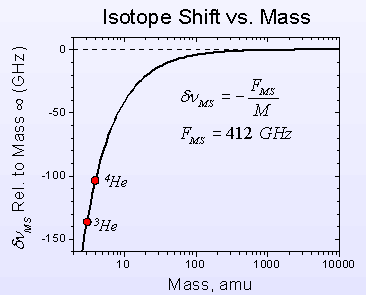 |
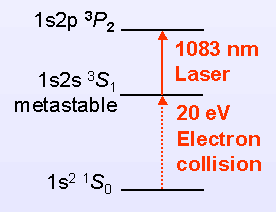 | In order to search for a weak absorption signal and avoid Doppler-broadening, we perform FM saturation spectroscopy on the 1083 nm transition from the metastable triplet level in helium. The gas sample was enclosed in a quartz glass cell, in which a RF-driven discharge was used to populate the metastable level. The system sensitivity was calibrated using 3He, whose abundance in air is 1.4x10-6 relative to 4He. For 3He we reached a S/N of 70. The 3He lineshape was used as a template when looking for a possible strangelet signal. Altogether we scanned a frequency range from -86.3 GHz to 3.1 GHz relative to the infinite mass point with a 3 MHz resolution. |
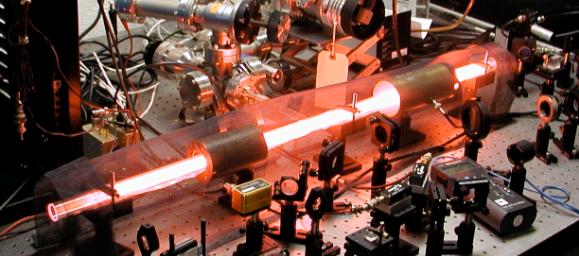 | |
Gas SamplingThe helium sample was extracted from air with sorption pumps cooled to 80 K with liquid nitrogen, thus effectively absorbing all major gases in air except neon, helium and hydrogen. The remaining gas was compressed with a turbopump into the previously evacuated quartz glass cell. | 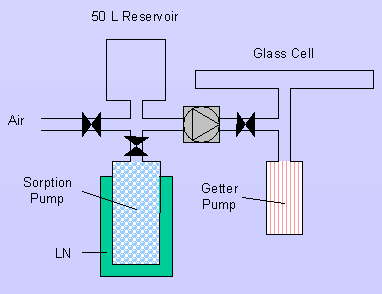 |
Results

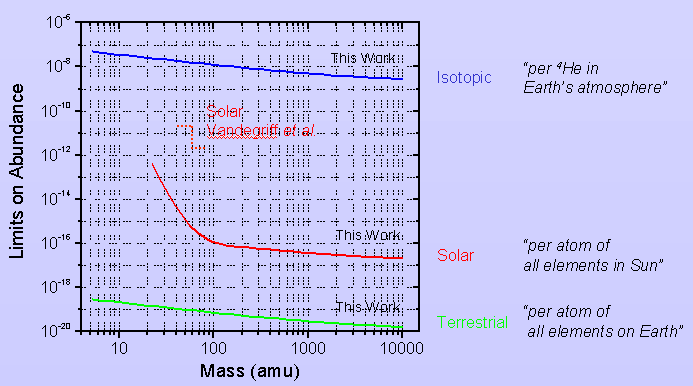
This work is supported by the U.S. Department of Energy, Contract W-31-109-ENG-38.
References
Search for anomalously heavy isotopes of helium in the Earth�s atmosphere PRL Abstract / Preprint (nucl-ex/0302025)P. Mueller, L.-B. Wang, R. J. Holt, Z.-T. Lu, T. P. O�Connor, and J. P. Schiffer
Physical Review Letters 92, 022501 (2004)
Laser spectroscopic measurement of helium isotope ratios GRL Abstract / Preprint (physics/0311121)Physical Review Letters 92, 022501 (2004)
L.-B. Wang, P. Mueller, R. Holt, Z.-T. Lu, T.P. O�Connor, Y. Sano, N.C. Sturchio
Geophysical Research Letters 30, 1592 (2003)
Geophysical Research Letters 30, 1592 (2003)
![[Argonne Logo]](/images/argonne_header_logo.jpg)
![[DOE Logo]](/images/header_doe.gif)